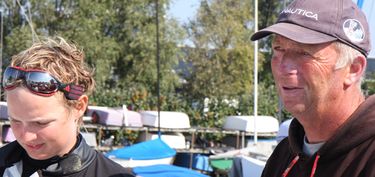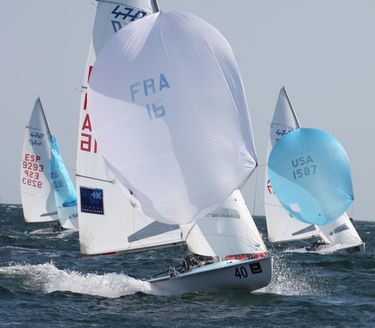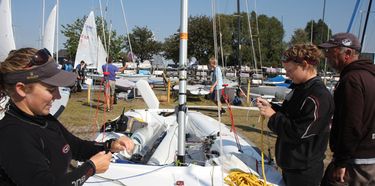Dybere forståelse for 470-satsningen
Pete Conway, Sejlunionens performance manager og landstræner, fortæller her om Henriette Koch og Lene Sommers 470 VM-satsning på hjemmebane. Artiklen er på engelsk.
Pete Conway, 470 og landstræner skriver:
If it was easy, then everyone would be doing it and winning! I refer to winning an Olympic medal and the campaign process; this of course includes the World Cup, European Championships and World Championships.
This article is about our process as the 470 team. Week in, week out we have been the most successful team in the world, until the World Championships, when things went wrong. Here is an analysis of our process and the story behind it.
Visonen om OL-guld 2012
This article also hopes to share with you the absolute need to keep our vision on the end goal – a Gold medal in 2012, whilst gaining success along the way. Sometimes the outcome of a decision is bad, but the decision is necessary in order to fulfil our program.
The consequences of being thorough in our research program is not always to deliver the best result of the moment, but it makes us stronger in our quest for gold!
An Olympic campaign runs in many different paths. Some sailors try to anticipate the qualities and type of sailing that an Olympic venue needs and then focus on them for two years prior to the Games.
This can lead to vulnerabilities in unusual conditions, but explains why the world’s best sailors do not always win and get overtaken by the “nearly men”.
Other experienced sailors know that they have all the skills so try to keep in contact with the sport for two years after an Olympic year, then simply try to “peak” during the next Olympic year.
Historically this has been moderately successful, but not in Qingdao. There is only one chance in 4 years, and the major nations are determined to get the gold!
Korte kampagner er slut
The DS Coach and Management team have analysed the system and the patterns of successful international federations and realise that the day of the short campaign is now over.
Almost all the medals in China were taken by full time sailors, who spend over 200 days a year in the boat, are fit, tactically aware and have the opportunity to train in the best conditions for the entire four year period before the Games.
Some nations spend more on building equipment and trying to get little advantages than we do on our entire Olympic campaign. Small details can make a decent sailor good, or a good sailor great for a week. In other words, the pace has been raised.
Ingen 'bløde' felter i World Cup, EM eller VM
No longer do we see “soft” fleets, either at World Cup events or at EM or VM.
The level of competition here in Denmark for the recent round of World and European Championships proves that the pace does not slack off.
Sometimes the major players of a class will be changed the year after an Olympiad, but last year’s “losers” pick up the pace and run very fast. Fleet standards vary, but not in the same way or for the same reasons as in the past.
Plan med teknik, taktik, fitness, udstyr, logistik, finansiering og support
We split our campaign planning into many different areas. Essentially we have a four year plan. The plan is divided into technical, tactical, fitness, equipment, logistics, finance and support. In this article we will discuss the equipment process of 2009, and the reasons for our decisions.
One of the great mistakes that medal candidates make in Olympic year is to experiment with new equipment. Rarely do people find that extra 1 or 2% of speed or VMG which will launch them to Gold.
The “code zero” spinnakers which were used by the USA in the Tornado fleet are a great example of this – their last place made a mockery of the time and effort that went into this project.
Finn sailors excel at finding tweeks of the weeks. Laser sailors change physical shape and strength, and usually do not do too well with the new shape. 470 people have built new boats which are revolutionary and then do not perform to expectations.

Målet i 2009 - den bedste jolle
So our goals for 2009 have been to establish ourselves as one of the leading 470 boats, whilst meeting the challenge of the equipment jungle through this year, rather than during 2012! The equipment goal is to sail with the same equipment through 2011 and 2012.
Our technique program has been to evolve a sailing style which will be strong and where our light weight will be an advantage.
This means that we have to combine technical development (meaning our style of sailing) with equipment development – the equipment having to support our evolving sailing style, which is innovative in the fleet, and we have ambition to make it “Elvstrom style”.
So the evolution of our sailing style means that we have been sailing in “low mode” style all year. This means that we are always fast, and can afford to lose positions in the first part of a race in order to get a free position where we can use our speed.
Typically we have usually caught the leading group by the first upwind mark, then we gain around the course and often end up in the first three boats across the finish line. Easy!!! Our downwind speed is already good and is developing all the time, and our upwind speed is usually excellent.
Back to the equipment program – and more specifically boats. Our plans for this year have been to test the three major brands of boats. Within the 470 class there are three major brands – Nautivela, Blue-Blue (Ziegelmeyer) and Mackay.
Mackay er mest populært
Most of the best sailors use Mackay. This design enables them to sail high to the wind, and at a decent speed. The sails most commonly used by the good sailors are North (Japan), which are very full and do not suit our weight (we know – we have tried them!).
The Blue Blue is the boat we have won the World Cup with. This has been a great boat, and is flatter underneath than the Mackay. The Nautivela is the boat that we have sailed since starting in the 470 class, and the last time we sailed it we won Miami OCR in January 2009.
Its shape is somewhere between the other two, and its vulnerability is that it goes “soft” very quickly and is not as consistent in construction as the other two.
Until July, our evolution was solid. We were sailing Blue Blue, making small and consistent alterations to our technique and setup, and getting faster.
The Mackay we had booked down for testing was delivered in July, and we sailed it in Travemunde regatta for the first time and got 2nd place in quite a high wind regatta. There was not a great fleet, but enough good sailors for us to measure pace.
We then practised in the Mackay and our plan was to make a decision as to which boat we sailed for the Worlds on August 8th.
It became clear that we could hold a higher lane from the start easier than in the Blue Blue, and we made a rig alteration which improved further on this. The boat felt wonderful and responsive to steer.
Førte i practice race
In practise races we kept leading the Ladies fleet, beating the French and Dutch girls (the ones who went on to win Gold and Bronze) far more often than they beat us. We made the decision to use the Mackay. Then we did really well in the pre Worlds – a regatta organized by Jan Christiansen from DS at the Worlds venue.
During this entire time we knew we were racing smart and sailing well. The conditions were fairly stable in windspeed and very shifty on angles. We entered the Worlds in a very positive frame of mind.
On the first day it became obvious that we had a few speed problems in slightly different conditions to the evaluation period. The wind was both shifty and patchy with fairly large velocity differences.
We kept putting ourselves in good positions, then would not have the speed to consolidate our good positions. It was not conclusive, but a conclusive sign that something was majorly wrong............

Anden dag ved VM: En katatrofe
The second day was a disaster. We had gathered all the information about currents, and had taken readings on the course. All the pressure was down the left, and we knew this was the way to go.
When the French, Italians, Argentinians and two other top boats went left with us, that was a great sign that we were on a winner. None of these teams make too many wrong judgement decisions about current.
The start was tight, and a lot of the fleet was spat out to the right of the course. When we tacked it looked as though we were in a very strong position.
Unfortunately further up the course it became obvious that the slack current on the far right was dominating the results, and we were in the loser’s fleet by a big margin! Race 4 was a simple one way course.
We sailed aggressively, were leading for over half the race, but did not have the speed to hang on to the Dutch and Spanish boats, so finished 3rd.
Rig sat forkert op til femte sejlads
Race 5 we simply set the rig up entirely wrong for increasing wind conditions, could not make the boat respond to normal controls and did not have speed or height – result 21st!!
The qualifying over and we had reached the gold fleet comfortably despite our many problems and shrinking confidence.
We had a good first day of the gold fleet with 2 solid top 10s, but again were not able to get enough speed to play our usual solid tactical game. However, we shot up the leaderboard and things looked more promising.
Then the track became a speed track, where it was a huge disadvantage not to be fast, and our event fell apart.
The flaws in our preparation suddenly became very obvious, and we are now in a position to begin the evaluation of these flaws.
Kunne have sluttet på 12. plads
We also recognize that our inexperience at dealing with adverse problems meant that we finished 18th when we probably could have finished 12th if we had taken the opportunities presented in the way more experienced crews would have done. We still have much to learn!
The full evaluation process will be over the next few weeks, but has already begun.
We are already programmed to go to Miami, where we will be working for around 10 – 12 hours a day.
The main part of our program there was already fixed and we will be developing faster sails for already fast Blueblue boat.
We did not realize that we would need another and very different set of sails if we decide to stick with the Mackay as a manufacturer, as we thought that all boats within the class would sail in a similar but slightly different manner.
The difference in our case, with our necessary flat sail setup felt like we were sailing a different class of boat!
It felt as though the weather and wind went against us, and the combinations of our flat sails and Mackay hull shape were catastrophic to our result. We would have loved to have had this information before the regatta!
The good news is that we recognize the need to investigate the two different types of “class within the class” and are now taking both boats to the USA.

Mackay med mere V-form
We have positively identified reasons and logic why the Mackay with more V shape needs a different rig (or engine!!) and we have an opportunity to confirm that we were previously on the correct path.
We will borrow some full sails and investigate if there is any chance to improve the Mackay boat to our Blue blue standard.
We are running this campaign in as professional a manner as possible. We made an error of judgement based on the evidence that we had when selecting the boat for the Worlds, but we had to test this boat in serious competition.
The cost was the result, but the benefit is that we now have a very specific test program through the winter.
If we did not have this information, we could have wasted hundreds of hours in Miami thinking that we were on the right path with the Mackay, and not recognized its vulnerabilities until next year. Maybe this will “cost” will prove positive in the end for us!
We are extremely grateful to our wonderful friends and our friends in the press for the support you give to us.
We hope to be able to share our campaign with you some more, and hope that you have enjoyed reading the reasons behind our result - at the same time we are very sorry that we did not deliver the result that we were hoping to bring the team.
We also hope that sharing the big picture will enable our friends to understand the complexities and decision making which goes into our Olympic campaign.
Sejlerhilsener
Henriette, Lene and Pete


